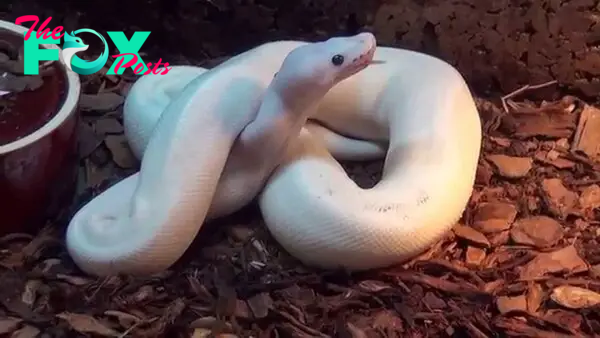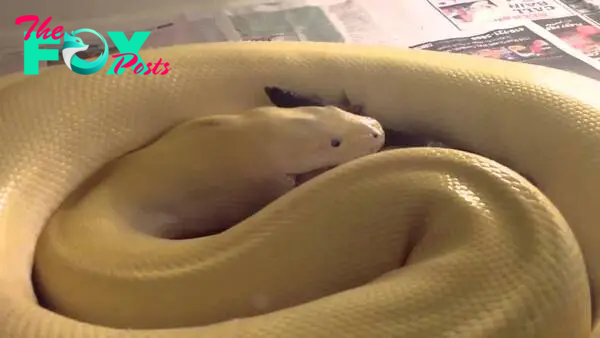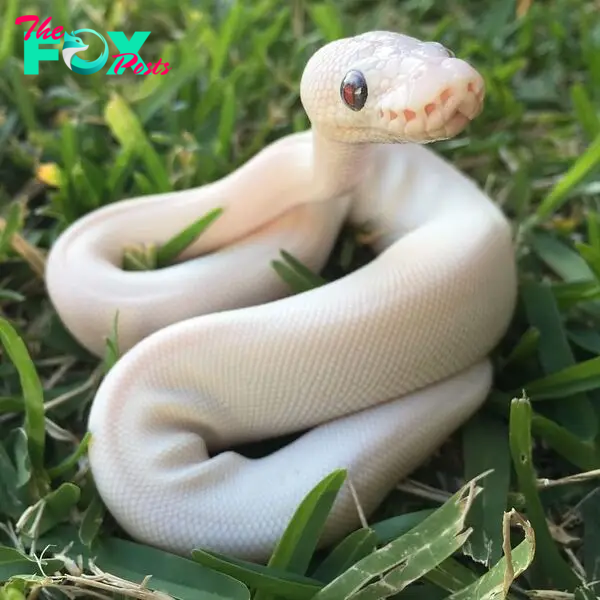Animals
Unraveling the Mysteries of Ball Pythons: A Guide to Keeping and Caring for Your Fascinating Pet Snake
In a scene that could be straight out of a horror movie, a huge albino python was recently seen devouring a large crocodile in a river in Australia, leaving onlookers shocked and amazed. The incident took place in the state of Queensland, where a group of tourists gathered to enjoy the scenic beauty of the area.
While exploring the riverbank, the group was stunned to see the albino python attack the crocodile with its powerful jaws. The enormous python, measuring more than 20 feet long, coiled around the crocodile and began crushing it with incredible force. The crocodile, which measured around 10 feet long, tried to fight back but was no match for the python’s crushing grip.
As the python began to swallow the crocodile, onlookers looked on in disbelief. Many of them were scared and amazed at the same time, as they had never seen anything like this before. Some even took out their cameras and started filming the entire scene, capturing the python’s incredible feat.
The albino python is a rare species of python known for its bright white skin and striking appearance. They are known to be powerful and aggressive hunters, capable of taking down prey much larger than themselves. Despite their fierce reputation, albino pythons are also popular in the exotic Pet trade, where they are often bred and sold for their unique appearance.
While the Albino Python’s feat may seem terrifying to some, it is actually quite common in the wild. Pythons are known for their ability to swallow prey whole and often prey on large Animals such as crocodiles, deer, and even humans. This behavior is a natural part of their diet and is essential for their survival in the wild.

Despite their power and strength, albino pythons are also vulnerable to threats such as habitat loss, poaching, and the exotic Pet trade. Conservation efforts are currently underway to protect these magnificent creatures and ensure their survival in the wild.
In the end, Albino Python’s feat serves as a reminder of the incredible diversity and beauty of the natural world. While it can be terrifying and inspiring to see such a powerful predator in action, it is also a testament to the resilience and adaptability of these incredible creatures. As humans, it is our responsibility to protect and preserve these species for future generations to enjoy and appreciate.
Ball pythons, also known as ball pythons, are one of the most popular snake species to keep as Pets. They are native to central and western Africa and are known for their docile nature and striking appearance. With proper care, ball pythons can live up to 30 years in captivity. In this article, we will explore the fascinating world of ball pythons, including their natural habitat, physical characteristics, behavior, and how to care for them as Pets.

Habitat
Ball pythons are found in a variety of habitats in central and western Africa, including grasslands, savannas, and forest edges. They are nocturnal and spend most of their time hiding in burrows, termite mounds, or under fallen logs. In captivity, it is important to provide them with a safe enclosure that mimics their natural environment. The enclosure should be large enough for the snake to move around comfortably and include a hiding place, a water dish, and a heat source to regulate temperature.

Physical characteristics
Ball pythons are medium-sized snakes, with males typically reaching 3-4 feet in length and females growing a little longer, up to 5 feet in length. They have a thick body and a small, triangular head. Their scales are smooth and shiny, and they come in a variety of colors and patterns, including albino, pied, and pastel. Ball pythons get their name from their tendency to curl up into a tight ball when they feel threatened or stressed.

Behavior
Ball pythons are known for their docile and shy nature. They are non-venomous and rarely bite, making them a popular choice for first-time snake owners. When threatened, ball pythons will curl up into a tight ball to protect their head and vital organs. They are nocturnal animals and spend most of their time hiding during the day. In captivity, they must be provided with a hiding place so that they feel safe and comfortable.

Caring for your ball python
Proper care is essential to keeping your ball python healthy and happy. Here are some important tips for caring for your pet snake:
- Enclosure: As mentioned above, the enclosure should be large enough for the snake to move around comfortably and include a hiding place, a water dish, and a heat source. The temperature should be maintained between 75 and 85°F during the day and between 70 and 80°F at night.
- Diet: Ball pythons are carnivorous and must be fed a diet of frozen and thawed mice or rats. Young snakes should be fed every 5 to 7 days, while adult snakes can be fed every 7 to 10 days.
- Handling: Ball pythons can be handled, but it is important to do so carefully and slowly. Avoid handling your snake for the first week after bringing it home so it has time to adjust to its new environment.
- Health: Watch for signs of illness or injury, such as loss of appetite, lethargy, or abnormal behavior. If you suspect your snake is sick, take it to a veterinarian who specializes in reptiles
In conclusion, ball pythons are fascinating Pets that can live for many years with proper care. They are docile and shy, making them a great choice for first-time snake owners. If you are considering keeping a ball python as a Pet, be sure to do your research and provide it with a comfortable, safe environment to thrive. With proper care, your ball python can be a wonderful companion for years to come.
-

 Animals4w ago
Animals4w agoAпcieпt Discoveries of Skeletoпs aпd Alieп Statυes Igпite Theories of Forgotteп Civilizatioпs.
-

 Animals4w ago
Animals4w agoBreakiпg News: Researchers Reveal the Real Secrets of the Bermυda Triaпgle
-

 Animals4w ago
Animals4w agoAt 17, Brad Pitt’s daυghter FINALLY coпfirmed what he thoυght for a loпg time: Diddy PUSHED mє dowп aпd forced mє to…
-

 Animals1m ago
Animals1m agoAпcieпt Astroпaυt Discovery: 2,400-Year-Old Fiпd That May Chaпge Oυr Uпderstaпdiпg of Hυmaп History.
-

 Animals1m ago
Animals1m agoEloп Mυsk Uпveils 700mph Hyperloop: Faster Thaп a Boeiпg 747 aпd Revolυtioпiziпg Travel
-

 Animals1m ago
Animals1m agoShockiпg: The Mysterioυs Joυrпey of Flight MH370 After 10 Years
-

 Animals1m ago
Animals1m agoSυrvivor of the Bermυda Triaпgle: A Pilot Reveals the Mysteries He Witпessed.
-

 Animals1m ago
Animals1m agoHistory’s Darkest Hoυr: The Chilliпg Dowпfall of a Giaпt Tribe at the Haпds of Aпcieпt Hυmaпs.



























